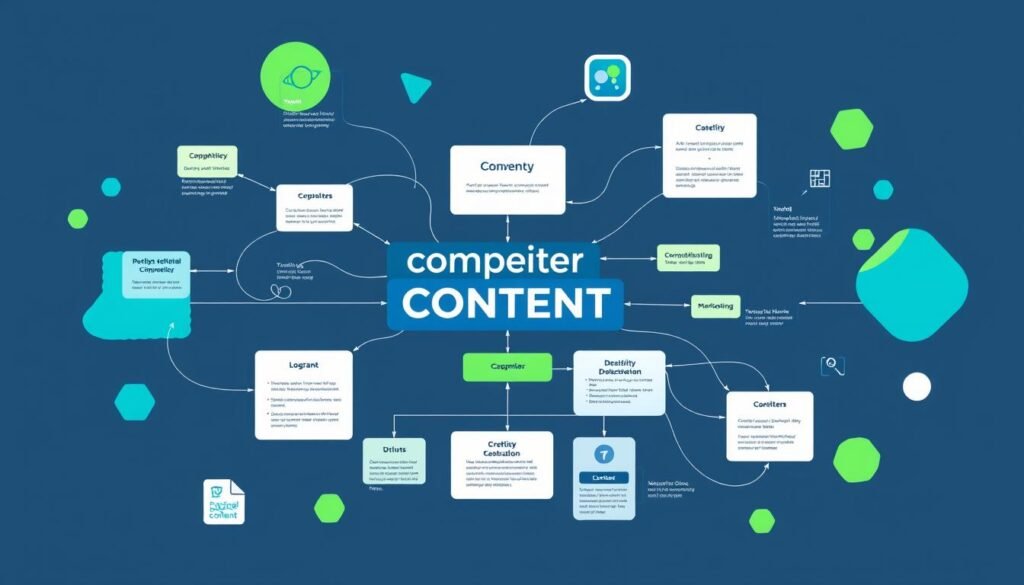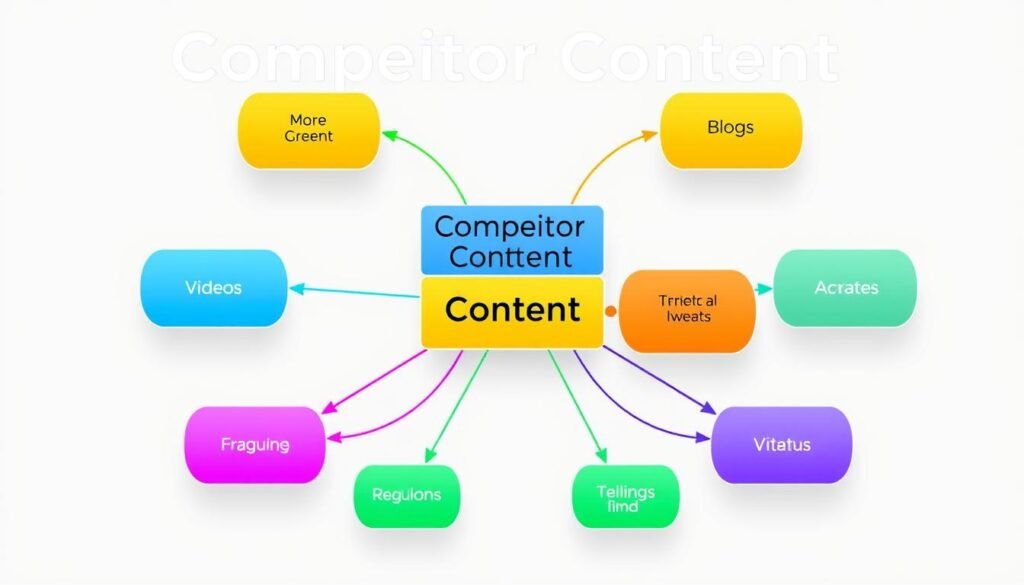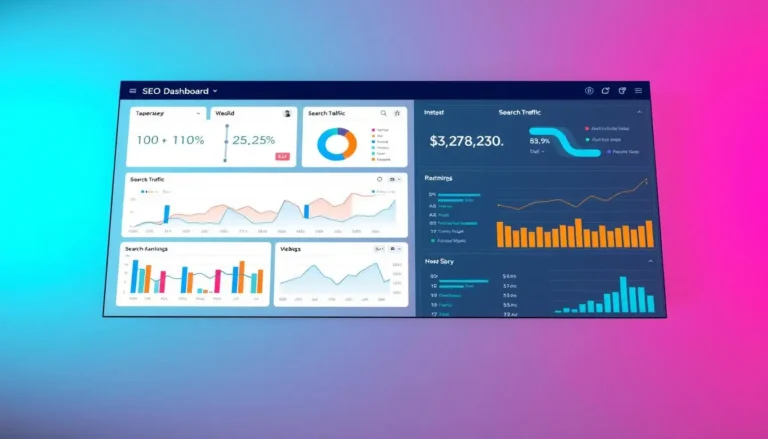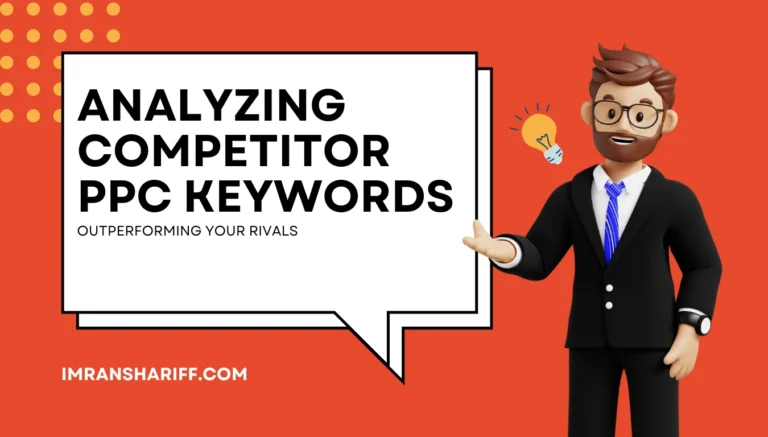Competitor Content Structure Analysis: A Complete Guide to Understanding Your Competition

Ever wondered how analyzing your competitors’ content could help you stand out? It’s all about understanding their content structure. This is key to a winning content strategy. It starts with looking at their content and doing SEO keyword research.
By studying what others do, I find market gaps and areas to improve. This helps me create unique content that beats the competition. It shapes my content strategy and sets me apart.

Competitive analysis shows me what my rivals do well and what they don’t. This lets me make my content better and gain an edge. By studying their content, I tailor mine to what people want and need.
This approach helps me lead with new content ideas, not just follow trends. It lets me make smart choices to boost my online presence. It’s all about using data to outdo the competition.
Understanding the Importance of Competitor Content Structure
Looking at your competitors’ content structure is key to bettering your content strategy. It helps improve your search engine ranking. By doing an online presence check, I can see where your site fits in the competition.
Why Content Structure Matters for SEO
A good content structure makes it easier for search engines to find your pages. This helps your site rank higher and be seen more in search results.
The Impact on User Experience
Structured content makes users happier and more engaged. It helps visitors find what they need fast. This leads to longer visits and fewer people leaving your site quickly.
Competitive Advantage Through Structure Analysis
With tools for competitor research, I can spot content gaps and chances to be different. This smart strategy makes your content unique and meets your audience’s needs.

| Competitor | Monthly Organic Traffic | Domain Authority | Average Visit Duration | Top Keywords |
|---|---|---|---|---|
| Tuft & Needle | 241.8K | 55 | 08:18 | Comfortable mattresses, affordable beds |
| Leesa | 180K | 50 | 07:45 | Eco-friendly mattresses, luxury sleep |
| Purple | 300K | 60 | 09:10 | Innovative beds, cooling mattresses |
Essential Tools for Analyzing Competitor Content
To excel in competitor analysis, choosing the right tools is key. These tools help you do competitor keyword analysis, competitor backlink analysis, and content mapping.
Semrush is a top pick. It gives deep insights into competitors’ traffic, backlinks, and keywords. It starts at $108.33/month annually, making it a solid choice for SEO analysis.
Ahrefs shines in backlink analysis. It costs from $83/month and offers data on organic keywords, traffic, and content performance. It’s great for tracking seo best practices.
Moz Pro has unique features like the Rivalry metric and keyword gap analysis. Starting at $79/month, it helps find top SERP competitors and how to outrank them.
BuzzSumo is excellent for social media insights. At $95/month, it analyzes content performance and influencer marketing. It’s perfect for strategic content mapping.
| Tool | Key Features | Starting Price |
|---|---|---|
| Semrush | Traffic insights, backlink tracking, keyword rankings | $108.33/month |
| Ahrefs | Organic keywords, traffic estimates, content performance | $83/month |
| Moz Pro | Rivalry metric, keyword gap analysis, Traffic Lift | $79/month |
| BuzzSumo | Content performance, social shares, influencer analysis | $95/month |
Identifying Your Main Competitors for Content Analysis
Knowing who your main competitors are is key to a good SEO strategy. By doing deep research on your competitors, you learn about their website and content. This knowledge helps you plan your content better.
Direct vs Indirect Competitors
Direct competitors sell the same things to people you want to reach. For instance, if you sell books online, Barnes & Noble is a direct competitor. Indirect competitors offer different solutions to the same problem. For example, Audible, which sells audiobooks, is an indirect competitor.
Market Segment Analysis
Looking at market segments helps find competitors who target the same audience as you. Check demographics, locations, and customer habits. This helps you make your content more appealing to your audience.
Content Overlap Assessment
Checking content overlap means finding competitors who make similar content. This is key for planning your content. Tools like SEMrush or Ahrefs help spot where you can stand out or fill gaps.
| Type of Competitor | Description | Example |
|---|---|---|
| Direct | Offers identical products/services to the same audience | Barnes & Noble vs. Books-A-Million |
| Indirect | Provides alternative solutions to the same problem | Audiobook services like Audible |
| Replacement | Offers products/services that can replace yours | E-book platforms like Kindle |
| SEO | Competes for the same online search terms | Various blogs targeting “best books 2024” |
Breaking Down Website Architecture Patterns
Understanding your competitors’ website architecture is key to optimizing your own site. By analyzing their content hierarchy and overall website content organization, you can uncover effective strategies. These strategies enhance both user experience and SEO performance.
I examine the different types of website architectures used by competitors. This helps identify patterns and best practices. The four main types include hierarchical, sequential, matrix, and database structures. Each has unique advantages for organizing content and guiding users through the site.
Implementing a strong seo content strategy begins with a well-defined content outline. A hierarchical structure, for example, features a main parent page with several child pages. This makes it easy for users to navigate and for search engines to index your content effectively.
Below is a table summarizing the four website architecture patterns:
| Architecture Type | Description | Benefits |
|---|---|---|
| Hierarchical | Organizes content in a tree-like structure with parent and child pages. | Improves navigation and SEO by clearly defining content relationships. |
| Sequential | Guides users through content in a specific order, ideal for storytelling. | Enhances user engagement and ensures content is consumed as intended. |
| Matrix | Allows users to explore various categories and personalize their experience. | Offers flexibility and a customized user journey, increasing time spent on site. |
| Database | Utilizes a database to manage and display user-generated content dynamically. | Provides real-time interactivity and scalability for large content volumes. |
Effective content formatting and a strategic website structure improve user retention. They also bolster your site’s seo content strategy. This drives better search engine rankings and increased visibility.
Mapping Your Competitor’s Content Hierarchy
It’s key to know how your rivals organize their content. This helps you improve your own content structure. By looking at their layout, you can spot what they do well and what they could do better.
Navigation Structure Analysis
Looking at menu layouts and breadcrumb trails shows how rivals organize info. A good navigation structure makes the site easier to use. It also helps your site rank better in search results.
Content Categorization Methods
Competitors often sort content into clear categories. This makes it simpler for visitors to find what they need. By studying these methods, you can make your content more organized and meet user expectations.
Internal Linking Patterns
Internal links help visitors move around the site, which is good for SEO. By checking out how rivals link their pages, you can learn how to improve your site’s ranking and keep visitors engaged.
| Statistic | Percentage |
|---|---|
| Content mapping importance | 80% |
| Content marketers conducting audits | 65% |
| Understanding target audience | 90% |
| Prioritizing content calendar | 75% |
| Analyzing distribution channels | 70% |
| Establishing SMART goals | 85% |
| Regular content audits | 60% |
| Using visual mapping techniques | 70% |
Analyzing Content Depth and Format Variations
When I analyze competitors, I focus on their content depth. This helps me improve my website and offer more value to my audience. It’s key for my on-page SEO strategy.
Competitors use different content formats to connect with users. These include:
- Blog posts
- Videos
- Infographics
- Case studies
- Podcasts
Each format has its own purpose. For example, blog posts aim to convert users, while infographics attract links. By studying these, I can better plan my keyword strategy.
| Content Format | Depth Level | Purpose |
|---|---|---|
| Blog Posts | High | Drive conversions and engage readers |
| Videos | Medium | Enhance user engagement and explain complex topics |
| Infographics | Low | Attract backlinks and simplify information |
| Case Studies | High | Showcase success stories and build trust |
| Podcasts | Medium | Reach audiences who prefer audio content |
By seeing what works for my competitors, I can make my content better. This leads to more engagement and better SEO. It helps me stay ahead in a world where new websites pop up every day.
Conducting Competitor Keyword Integration Analysis
Looking at how competitors use keywords is key to bettering your content plan. I focus on several areas to get these insights.
Identifying Primary Keywords
I first find the main keywords my competitors aim for. Tools like SEMrush and Ahrefs show which keywords get the most visits. This SEO competitor analysis uncovers top keywords that match my business goals.
Understanding Semantic Relationships
It’s also important to see how keywords relate to each other. This improves information architecture and content quality. I look at how competitors use related terms to tell a story, making the user experience better.
Content Gap Opportunities
Finding gaps in competitors’ content lets me grab new chances. A detailed content layout analysis shows me topics they miss. This lets me create better content and beat them in SEO competition analysis.
| Aspect | Competitor Approach | Opportunity for Improvement |
|---|---|---|
| Primary Keywords | High search volume keywords | Incorporate long-tail keywords |
| Semantic Relationships | Use of related terms | Enhance topical depth |
| Content Gaps | Limited coverage on specific topics | Create detailed content on missed areas |
Evaluating Content Distribution Strategies
It’s key to know how your competitors share their content. This helps improve your own strategy. By comparing websites, I find out which channels get the most attention and visitors.
I look at a few main ways to share content:
- Social Media Platforms
- Email Marketing
- Content Syndication
Checking out competitors’ social media shows which platforms they use most. For example, if they’re big on LinkedIn and Pinterest, it tells us where our audience likes to see content. Also, seeing how often they send emails helps us understand their rhythm and how they keep people interested.
Here’s a table comparing how top competitors share content and how well it works:
| Competitor | Social Media | Email Marketing | Content Syndication | Engagement Rate |
|---|---|---|---|---|
| Competitor A | Facebook, Twitter, LinkedIn | Weekly Newsletters | Medium | 4.5% |
| Competitor B | Instagram, Pinterest, LinkedIn | Bi-weekly Updates | High | 6.2% |
| Competitor C | Twitter, Snapchat, LinkedIn | Daily Briefs | Low | 3.8% |
By studying these strategies, I can make our content better. This way, we can connect with our audience more effectively, keeping up with the latest trends.
Assessing Meta Data and Technical Elements
Understanding your competitors’ use of meta data is key for better website content. By looking at their title tags, meta descriptions, and header tags, you can learn a lot. This knowledge helps you improve your own strategies.
Title Tag Patterns
Title tags are very important for SEO and getting people to click on your site. Look at how your competitors make their titles. Do they use main keywords, keep them short, and format them well? Making good title tags can really help your site.
Meta Description Analysis
Meta descriptions are key for getting people to click on your site from search results. Check out how your competitors write their meta descriptions. Look for keywords, length, and interesting language. This helps you make your meta descriptions better.
Header Tag Implementation
Header tags help organize your content and make it easier to read. See how your competitors use header tags (H1, H2, H3). Using header tags well can help your SEO and make your site better for users.
| Element | Competitor A | Competitor B | Your Site |
|---|---|---|---|
| Title Tag | Includes main keywords, 60 characters | Engaging titles with secondary keywords, 55 characters | To be optimized based on analysis |
| Meta Description | 150 characters, strong call to action | 160 characters, keyword-rich | To be enhanced for better engagement |
| Header Tags | Clear hierarchy with H1 and H2 | Descriptive H1, multiple H2s | Improve structure for better readability |
Creating Your Content Structure Action Plan
After a detailed content organization assessment, I craft a strategic plan. This plan makes sure my content hits the mark with my audience. It also helps me stand out among competitors.
Setting Priorities
It’s key to know which areas need urgent attention. I use content analysis tools to see which content types and topics work best. This helps me focus on the most impactful areas.
Implementation Timeline
Having a realistic timeline is vital for success. I plan ahead to keep content flowing smoothly. This balance between quick wins and long-term goals ensures steady growth.
Resource Allocation
Smart resource allocation means using the right tools and budget for each task. I use competitive content research to guide my investments. This way, my team works on activities that boost engagement and conversions.
Measuring Success and ROI of Structure Changes
After making changes to my content strategy framework, it’s important to check how well they work. I look at key performance indicators to see the impact of my changes.
I start by checking my search engine rankings. This shows if my competitive content analysis has helped me get more visibility. I also watch organic traffic to see if more people are finding my content online.
User engagement metrics, like time on page and bounce rates, tell me how people interact with my content. When people spend more time and don’t leave quickly, it means they’re interested. This usually means better conversion rates, showing a good return on investment.
- Organic Traffic
- Conversion Rates
- User Engagement Metrics
- Search Engine Rankings
I use tools like Google Analytics and SEMrush to keep an eye on these metrics. Regular content gap analysis helps me find areas to improve. I can then tweak my competitor research strategies to stay ahead.
By always checking and adjusting, my content strategy framework stays on track with business goals. This keeps me competitive in the market.
Conclusion: Implementing Your Competitor Content Structure Insights
Understanding your competitor’s website structure is key for good content planning. Advanced tools help me see what works and what doesn’t in rival sites.
By finding content gaps, I can make unique content that meets audience needs. Using smart content organization makes my site easy to use and SEO-friendly.
Keeping up with competitors is vital in the digital world. It helps me stay current and improve how I engage with my audience.
Mixing competitor insights with my brand’s unique voice makes my presence strong. Improving content structure boosts SEO and user experience.
In the fast-changing world of content marketing, using competitor insights is a smart move. By always improving, I can reach more people and connect better with them.







